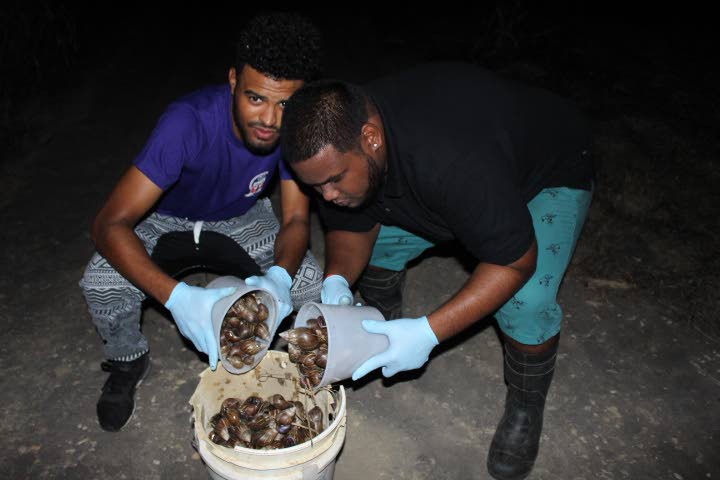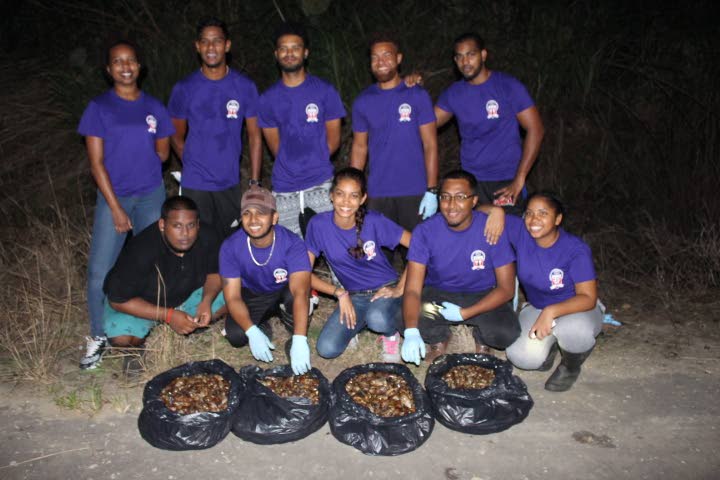The giant African snail

VOLUNTEERS from the University of Trinidad and Tobago (UTT) are on a drive to collect and subsequently eradicate the giant African snail.
They’re led by Nikita Samlal, a second-year BSc student of crop science and technology and Dr Marcus Ramdwar, assistant professor of agriculture.
Samlal is also president of the Waking up Agriculture Movement (WAM), a student-led community outreach group that aims to sensitise people on agricultural-related activities geared towards future food security.
Ramdwar is WAM’s faculty liaison officer.
The drive began on June 26.

Ramdwar explained that the snail poses a serious danger. It’s a threat to public health because it carries the rat lungworm, which causes a form of meningoencephalitis (an inflammation of the brain and surrounding membranes) in humans.
The public is at risk from eating agricultural produce from fields infested by snails.
The snail feeds on over 500 species of vegetation, so the threat is considerable.

Ramdwar said, “Given also that Trinidad is self-sufficient in vegetable production, the burden of this pest and threat to our local food security is significant.”
As of August 2017, Ramdwar said, “The snail has infested over 17 areas in Trinidad and is fast becoming more and more difficult to contain.”
Several farming districts are being affected by the snail, including Orange Grove, parts of Aranguez, Mt Lambert and Wallerfield.
The snail has also been found in areas such as Diego Martin since 2008, Maraval (2014), Invaders Bay (2014), Carenage (2015), St John’s Road, St Augustine (2016), St Joseph Village, San Fernando (2017), Chase Village (2017) and Santa Margarita (2017).
Ramdwar told Newsday once the snails are collected they will either be burned or submerged in a bucket of concentrated salt solution, then burned or buried.
About the giant African snail
The length of an adult shell may exceed 20cm, but usually averages between five and ten cm. The shell of fully-grown adults has seven to nine ridges or whorls and is normally reddish-brown, with faint yellowish vertical markings.
Ramdwar also said this pest reproduces rapidly, has limited predators, hibernates during unfavourable conditions such as in the dry season and is hermaphroditic, that is, it has both male and female sex organs.
The giant African snail is primarily nocturnal and usually becomes active at sunset.
“The snails are very active during the rainy season or during rainfall events in the dry season,” he added.
This snail can produce as many as 1,000 eggs annually during the rainy season, but can also reproduce and be active in the dry season once conditions are favourable.
Its average life span is between three to five years, though some adults live as long as nine years.
Watch out for the snails
The public is advised to wear gloves at all times when handling snails or working in areas where the snails are present or are suspected to be present.
The first step is to examine your property and to remove all possible hiding places for the snail.
These include bushy areas, debris, mulch, garbage heaps, compost heaps, logs, brick holes and blocked drains. The snail can also be found in trees, high on the sides of building and in open sewage tanks.
When you remove or discard items and debris, it is advised that you carefully inspect for the presence of snails and eggs first.
You should also inspect your car, since snails can infest new areas by “hitch-hiking” there.
How to get rid of the giant African snail
The snail can be crushed by stepping on them once you are wearing rubber boots. You should wash your boots with bleach solution after crushing the snails.
Crushed snails should be buried or burnt once you have approval for burning on your property.
The snails can also be drowned in a very concentrated salt solution once the container you use is filled completely to the top and covered for a period of 24 hours.
The dead snails should then be buried or incinerated.
Bag-salting snails can also be done by putting enough salt in a bag to completely cover the snails, tightly tying the bag and putting it into another bag which is also to be tightly tied.
The general public should inspect all locally produced fruits and vegetables for the snails, snailets (juveniles) and snail excreta.
Discard anything that has been contaminated by the giant African snail.
Ensure that all produce is thoroughly washed before preparation or consumption.
If you see one:
The giant African snail is now classified as a notifiable pest and must be reported to the Ministry of Agriculture, Land and Fisheries.
The snail hotline numbers are: Trinidad: 646-6284 and Tobago: 639-4616.


Comments
"The giant African snail"